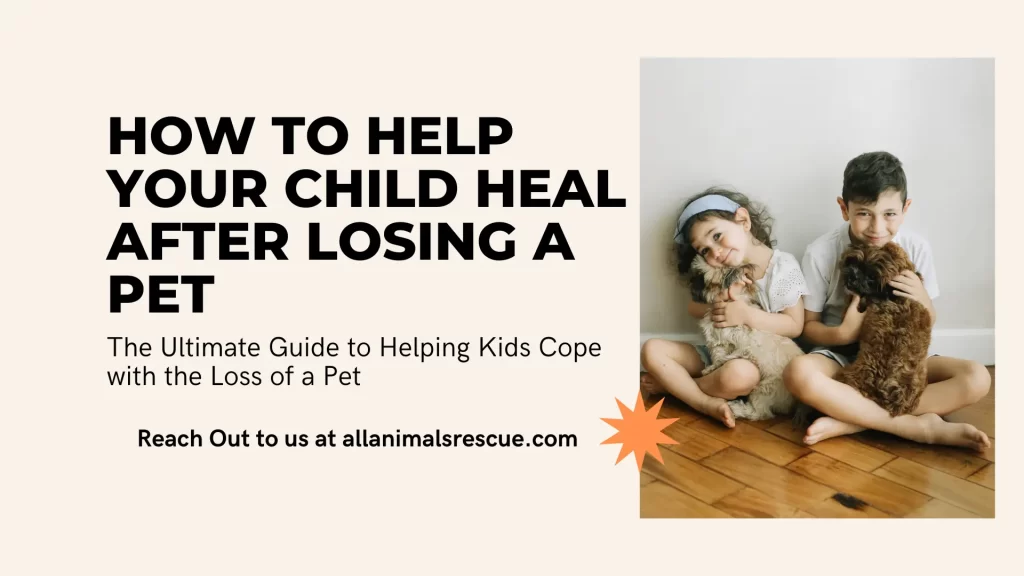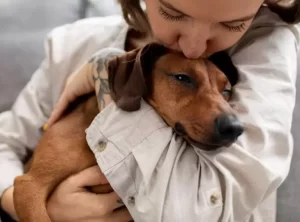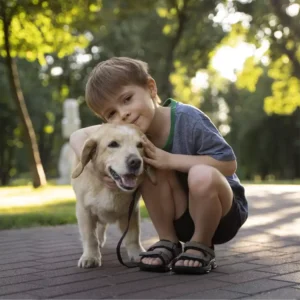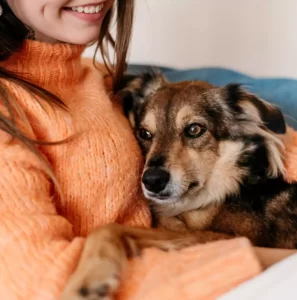Why Pet Loss Hurts So Much
Losing a pet is hard, especially for kids. Pets aren’t just animals. They’re part of the family. They give us love, comfort, and are often a child’s first best friend.
When a pet dies, it’s normal to feel sad. Kids may not understand what’s happening or how to handle their emotions. This guide will help you support your child through that loss.
We’ll talk about how kids react, how to explain death in a simple way, and how to help them feel better over time.
Understanding the Loss of a Pet
Why Losing a Pet Hurts So Much?
For kids, the bond with a pet is very special. A pet might be their favorite playmate, a buddy who listens, or the one who made them feel safe. So, when that pet dies, it can feel like their whole world has changed. Kids may feel confused, scared, or even angry.
- Important Resource: Children and Pet Loss (American Academy of Child & Adolescent Psychiatry) Offers insights into how children perceive and cope with the death of a pet, along with guidance for parents.
Helping your child starts with letting them know it’s perfectly fine to cry, to miss their pet, and to feel hurt.
How Children React to Pet Loss
Every child grieves in their own way. Some kids may cry a lot. Others may not say much at all. They might seem angry or act younger than they are. Some may stop eating or have trouble sleeping. So, these behaviors are normal.
Why Pet Loss Feels So Big for Kids
A pet is often a child’s first real friend. They play together, cuddle at bedtime, and grow up side by side. So when that pet dies, it might be your child’s first experience with death. That’s a big deal.
Kids may not have the words to describe what they feel. They might cry a lot, ask strange questions, or even get mad. Some might act like nothing happened. Others may struggle to sleep or eat. All of this is normal.
What matters most is that your child knows it’s okay to feel sad—or even angry. Losing a pet hurts, and it’s okay to show those feelings.
How to Talk to Kids About Death
When you talk to your child, be gentle but honest. Use words they understand. Don’t say the pet “went to sleep” or “ran away.” That can cause more confusion or fear.
You can say something like:
“Our dog was very old and sick. His body stopped working, and he died. We’re going to miss him a lot.”
🌟 For a young child (3–6 years)
“Our pet died, which means their body stopped working and they can’t breathe or move anymore. They’re not in pain now. It’s okay to feel sad or to miss them. We loved them very much, and it’s okay to talk about them whenever you want.”
🌈 For a school-aged child (6–10 years)
“Our pet died because their body wasn’t healthy anymore. This happens to animals and people sometimes when they get very sick or very old. It’s normal to feel sad or even angry. We can remember all the fun times we had with them, and we can talk about them whenever we feel like it.”
💬 For when a child asks, “Will they come back?”
“No, when someone dies, they don’t come back. But we can keep them in our hearts and memories. We can talk about them, draw pictures, or even make a special place in the house to remember them.”
Keep the message simple. Let them ask questions. And don’t worry if you don’t have all the answers. What your child needs most is your love and support.
Give Them Space to Feel
Grief is different for every child. Some kids want to talk about their pets every day. Others need quiet time. Some will cry. Some might act out.
Let them know all those feelings are okay.
Try to say things like:
- “It’s okay to cry. I miss her too.”
- “You can talk to me any time you want.”
- “Let’s draw a picture of him together.”
Let your child lead the way. Just be there.
If you’re also wondering what to do when a pet passes unexpectedly, especially during difficult hours, here’s a helpful guide: What to Do If Your Pet Passes Away at Night? Safe Storage Tips Until Morning.
Ways to Help Kids Express Their Grief
Creative activities can help kids process their emotions. Here are some simple ideas:
- Draw pictures of the pet.
- Write a letter to say goodbye.
- Create a memory box with photos, toys, or collars.
- Plant a flower or tree in the pet’s honor.
- Tell stories about silly or sweet moments with the pet.
- These little things can help a child feel closer to their pet—and help them heal.
- Watch for Signs They’re Struggling
Sometimes kids don’t know how to ask for help.
Looking for creative ways to honor your pet’s memory? Check out these 5 Amazing Pet Cremation Memorial Ideas.
Supporting Kids Through Grief
Signs to Watch For
Grief looks different in every child. But there are some signs that may show your child is having a hard time.
These can include:
- Trouble sleeping or eating
- Acting out or getting upset more easily
- Pulling away from others
- Saying they feel sick or have headaches
You might also notice them acting younger, like bedwetting or needing extra comfort. All of these are signs they need a little extra support and love.
- Imprtant Resource: Maricopa County offers feature articles and resources to help pet owners navigate the grieving process.
Healing Together as a Family
Grieving as a family can be healing. Talk about your pet together. Share stories or make a photo album. Maybe plant a tree or flowers in your pet’s memory.
Doing something as a family helps kids see that they’re not alone in their feelings—and that it’s okay to remember and miss their pet.
Planning ahead as a family can also bring peace of mind. Learn how to prepare with How to Make Arrangements for Your Pet’s End-of-Life Care.
Ways to Remember Your Pet
You can hold a small memorial or write a letter to your pet. Make a scrapbook, a drawing, or place a stone in your yard with their name.
Some families donate to an animal shelter in their pet’s name or volunteer together. These actions give kids a chance to say goodbye in their own way—and to honor their pet’s life.
Conclusion
When a pet passes away, it leaves an empty space that’s hard to explain. For a child, that space can feel even bigger. Their pet was a buddy, a listener, a part of every day.
Helping your child through this moment isn’t about having all the answers. It’s about being there. It’s sitting quietly when they’re sad, laughing at an old memory, or just saying, “I miss them too.”
Grief doesn’t follow rules. It takes time, love, and patience. But as your child heals, they’ll start to smile again—because the bond they had doesn’t end. It lives on in the stories you tell, the pictures you draw, and the love that never fades.
Frequently Asked Questions
How can we help kids deal with pet loss?
Start by letting them know it’s okay to feel sad. Be honest, gentle, and patient. Share memories, give hugs, and listen. Sometimes, just sitting quietly together helps more than words.
How can we help children say goodbye to a pet?
Let them say goodbye in their own way. They might want to write a letter, draw a picture, or hug their pet one last time. Let them be part of the goodbye, so it feels real and gives them some peace.
How long should a child grieve a pet?
There’s no “normal” time. Every child is different. Some bounce back quickly. Others may take weeks or even months. What matters is that you give them time, love, and space to feel.
What is the Rainbow Bridge explained to a child?
The Rainbow Bridge is a story people tell to help with loss (Read the Rainbow Bridge story here). It says pets go to a beautiful place full of sunshine and grass. They run and play until one day, they’re reunited with the people who loved them.
Are there any that specialize in pet loss?
Yes. Some therapists and support groups focus just on pet loss. There are also hotlines, books, and websites made to help families and kids through it. You’re not alone in this.
Still unsure about the right options? Here are 10 Questions to Ask When Choosing Pet Cremation Services in Glendale, AZ, that can help you make informed decisions.
How can I help my child cope with a loss?
Keep things simple and honest. Let them talk when they need to. Do activities like drawing or building a memory box. Just being there — listening, hugging, and not rushing — means a lot.
How could all of these feelings be caused by the death of a pet, especially one that I knew I would outlive?
Because pets are more than animals — they’re part of the family. They give comfort, love, and routine. Losing that leaves a big hole. Even when you expect it, the heart still hurts.
How did you handle your child’s first pet passing away?
We cried together. We talked about the good times. I let my child lead — if they wanted to talk, we talked. If they were quiet, I stayed close. We made a scrapbook and planted a flower in the pet’s memory.
How did you help your kids process their grief?
I helped by being there. No fancy words — just lots of hugs, open talks, and doing things together. We made art, watched old videos of our pet, and talked about how it’s okay to be sad.
How do I help my grieving child?
Show up. Let them feel. Give them time. You don’t need to fix the sadness — just walk with them through it. Small moments of kindness and comfort matter more than you think.
How do I know if my child is grieving?
Look for changes. They may act quiet, get angry, or seem tired. They might stop doing things they liked. It’s okay. These are signs their heart is hurting. Keep an eye on them, and keep talking gently.
How do children cope with the death of a pet?
Some cry. Some ask lots of questions. Some seem okay, then feel sad later. Kids grieve in waves. What helps is knowing they are safe, heard, and loved through it all.









